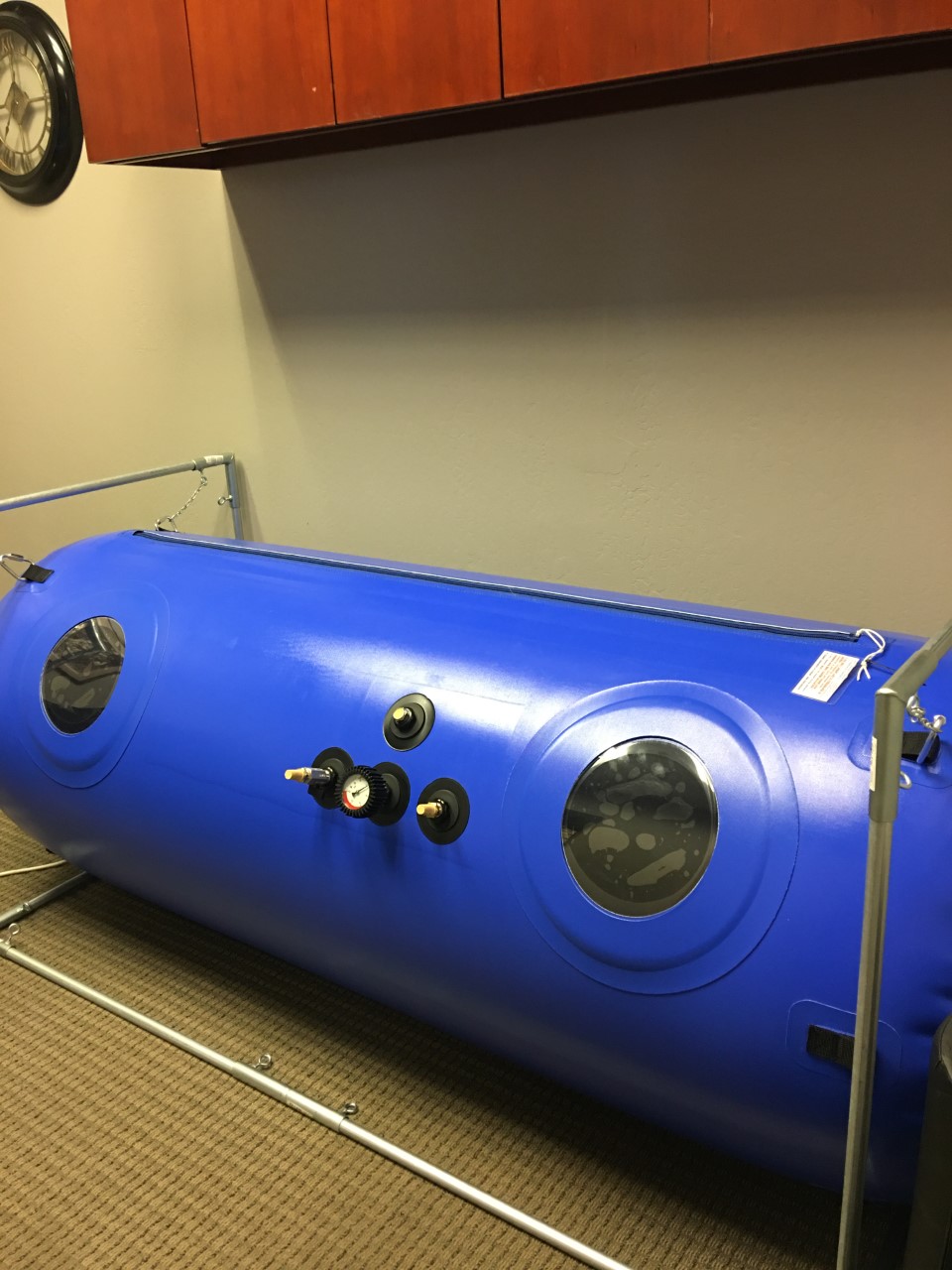ABG WELLNESS
Medical Therapies
ONLINE COURSES COMING SOON
ABG WELLNESS
Lymphatic Information
Manual Lymph Drainage, Pre-Operative and Post Surgical Manual Lymph Drainage

What is the Lymphatic System?
The lymphatic system is a network of vessels, nodes, and organs that help maintain fluid balance, support immunity, and eliminate waste from the body. It lacks a central pump like the heart and relies on muscle contractions and external pressure to move lymph fluid.
What is Manual Lymph Drainage?
Manual Lymph Drainage (MLD) is a technique initially developed by Dr. Emil Vodder in 1936 in Paris for treatment of swollen lymph nodes.
Manual Lymph Drainage is a gentle manual therapy technique. It should not be confused with a traditional massage. It is a light, rhythmic, skin mobilization combined with gentle pressure focusing on key areas of the body where the bulk of the lymph nodes and lymphatic vessels are found. Manual Lymph Drainage is coupled with deep breathing techniques called diaphragmatic breathing to help open the deep lymphatic pathways.
Manual Lymph Drainage is performed without heavy oils or lotion. Manual Lymph Drainage is NEVER painful or performed in an aggressive or vigorous manner. Manual Lymph Drainage does not hurt. The goal of Manual Lymph Drainage is to reduce inflammation, swelling, bruising and pain and to improve the function of the immune system.
Manual Lymph Drainage helps expedite the flow of excess fluid out of the tissues and return it to the circulatory system. The lymphatic system transports the excess fluids, along with some protein, fat, and metabolic waste to the liver and urinary system and it is eliminated.
Manual Lymph Drainage is recommended for: Lymphedema, Lipedema, Parkinson, Alzheimer, Dementia, Lyme Disease, Crohn’s Disease, Autism, Concussion, Pregnancy, Postpartum Recovery, Pediatric, Tissue Fibrosis, Heavy Metal Toxicity, Weight Loss & Detoxing the body.
Pre-Operative Manual Lymph Drainage (POMLD)
Pre-Operative Manual Lymph Drainage is a type of massage therapy that is performed before a surgical procedure to prepare the body for surgery. It involves gentle, rhythmic movements that stimulate the lymphatic system, helping to remove waste products, excess fluids, and other unwanted substances from the body. The primary goal of pre-op MLD is to optimize the cellular environment in the area of the body being treated and reduce the risk of post-surgical complications such as infection, excessive swelling, bruising, and scar tissue formation.
Benefits of Pre-Op MLD
- Stimulation of Lymph Vessels: MLD stimulates the lymph vessels of the lymphatic system, enhancing the removal of waste products and toxins from the body.
- Reduction of Post-Surgical Complications: By preparing the body for surgery, pre-op MLD can help minimize risks associated with surgery such as infection, swelling, bruising, and scar tissue formation.
- Facilitation of Incision: Clean and well-drained tissue resulting from pre-op MLD can make it easier for surgeons to make incisions during the procedure.
How to Prepare for Pre-Op MLD
- We recommend scheduling 1-3 sessions of manual lymphatic drainage massage prior to the surgical procedure.
- Sessions should be conducted within a week before surgery to ensure optimal preparation.
Pos-Surgical Manual Lymph Drainage (PSMLD)
Pos-Surgical Manual Lymph Drainage is a specialized form of massage therapy designed to aid in the recovery process after surgery. It involves gentle, rhythmic movements that help stimulate the lymphatic system, which plays a crucial role in removing waste and toxins from the body, reducing swelling, and promoting healing. PSMLD is performed by a trained therapists who have knowledge of the lymphatic system and specific techniques to address post-operative issues such as swelling, inflammation, and scar tissue formation.
Benefits of PSMLD
- Speeds up the over all healing and recovery time
- Boots the immune system
- Decreases inflammation
- Helps prevent infection
- Reduces stress & anxiety
- Accelerates Lymphatic flow
- Improves blood circulation
- Reduces excessive swelling & fluid retention
- Reduces scar tissue formation
- Improves skin quality & bruising
- Alleviates pain & discomfort
Post-Surgical MLD is recommended for: Liposuction, Mommy Makeovers, BBL (Brazilian Butt Lift) Face Lift, Breast Augmentation, Breast Reconstruction, Mastectomy, Rhinoplasty, Lumpectomy, Mastectomy, Joint Replacement.
Prenatal Massage & Postpartum Recovery
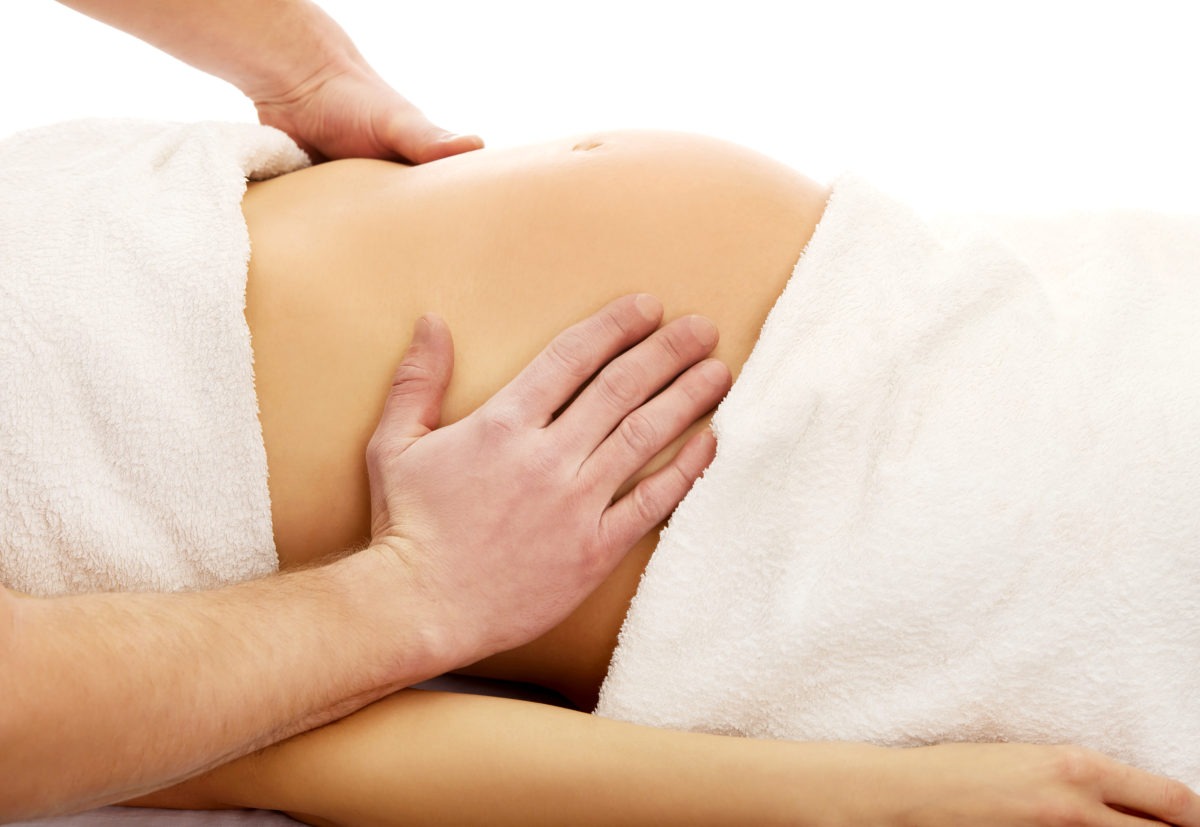
PRENATAL LYMPHATIC DRAINAGE MASSAGE is a gentle form of massage that encourages the flow and release of fluid held in the body’s tissues and assists in the body’s natural detoxification process and clears away toxins. Many women find lymphatic drainage massage is very beneficial especially in the third trimester. Fluid retention can be uncomfortable causing swollen ankles and legs. It’s essential to consult with your healthcare provider before receiving any form of massage during pregnancy to ensure it’s safe for you.
BENEFITS OF PRENATAL MASSAGE
- Reduced swelling
- Improved circulation
- Relaxation and stress relief
- Relieving aches on shoulders and neck
- Alleviation of discomfort
- Immune system support
- Detoxification
- Reduce cellulite and help tone the body
HOW TO PREPARE FOR PRENATAL LYMPHATIC DRAINAGE MASSAGE
- Hydration: Drink plenty of water and other hydrating liquids before and after the massage.
- Clothing: Wear loose-fitting, comfortable clothing that allows the therapist to easily access the areas being massaged.
- Eating: Eat a light meal before the massage, avoid heavy meals or caffeine for a few hours beforehand.
- Breathing: Deep breathing can help move lymph fluid through the lymph nodes and vessels.
- Elevation: Keep your feet and legs elevated above your hips to help fluid drain away. Use pillows to prop yourself up on a couch or in bed to support your body.
HOW TO REDUCE FLUID CONGESTION AT HOME
- Keep feet elevated above level of hips. Keeping feet and legs higher than your hips will allow fluid to drain away from legs and feet.
- Changing diet can help with reduction of fluid retention. Avoid or cut out as much as possible processed foods. Reduction of sugar is always a healthy choice and switch to natural forms of sugar such as fruits, and vegetables.
- Stay hydrated. This will help keep the lymphatic fluid moving.
- Keep active during pregnancy. This helps by using muscles in legs to pump fluid up from feet and legs
POSTPARTUM HEALING: SPEEDING UP RECOVERY
The postpartum recovery period typically lasts for the first six weeks. This period is crucial for the physical healing of your body.
After childbirth, your body embarks on a journey to heal itself from the physical demands of pregnancy and delivery. A postnatal lymphatic massage can speed up this healing process by reducing inflammation and promoting tissue repair.
It also aids in flushing out excess fluids accumulated during pregnancy which contributes to postpartum swelling.
Regular sessions can significantly decrease potential pain during the recovery period.
PROMOTING QUALITY SLEEP AND RDUCING PAIN
A good night’s sleep can be elusive for many new moms due to physical discomfort and the demands of a newborn. A manual lymphatic massage can help improve the quality of sleep by relieving tension in the muscles and promoting relaxation.
Manual Lymphatic massage can decrease potential pain a mom is in by reducing muscle soreness and joint stiffness. This can be particularly beneficial for high-risk pregnancies or those who have undergone a C-section, with doctor’s permission.
BENEFITS OF MANUAL LYMPH DRAINAGE FOR POSTPARTUM RECOVERY
- Reduced swelling
- Enhanced healing
- Pain relief
- Stress reduction
- Support for breastfeeding
Oncology is Part of Cancer Care
Roughly 1.8 million people will be diagnosed with cancer in the United States in the coming year, but the good news is, approximately two-thirds of those diagnosed will survive. Traditional treatments like surgery, radiation, and chemotherapy have had great success, but sometimes with crippling side effects that make the disease even more physically and emotionally taxing.
Oncology massage is an approach to massage therapy based in both compassion and specialized massage treatments to help people manage their experience with cancer.
New research is helping health care professionals and patients alike understand the role massage therapy plays in an integrative care plan. From providing stress relief to helping patients better handle symptoms such as pain and side effects like nausea, massage therapy can make an important difference for cancer patients.
Oncology Massage is a special type of massage developed specifically for cancer patients. Cancer patients have unique needs which must be addressed to make sure that a massage is beneficial to their health. A safe massage plan revolves around the side effects (both short-and long-term) of chemotherapy, radiation and surgery. Oncology massage should only be provided by a therapist who has received detailed cancer training.
Massage Therapy Benefits for Cancer Patients:
- Reducing pain
- Alleviating stress
- Relieving nausea
- Reducing depression and anxiety
- Improving sleep and lessening fatigue
- Preventing chemotherapy-induced peripheral neuropathy
- Relieving lymphedema
What is Lymphedema?
Lymphedema – Also called lymphatic obstruction is swelling in an arm or leg caused by a lymphatic system blockage.
The condition is caused by a blockage in the lymphatic system, part of the immune and circulatory systems. Lymphedema is most commonly caused by lymph node removal or damage due to cancer treatment.
The main symptom is swelling in an arm or leg that may be accompanied by pain or discomfort. Exercise, wrapping, lymphatic drainage massage, and compression can help.
Symptoms
Requires a medical diagnosis. The main symptom is swelling in an arm or leg that may be accompanied by pain or discomfort.
Pain areas: in the arms or legs or skin
Skin: dimpled skin like an orange peel or rashes
Also common: swelling in extremities, swollen lymph nodes, or water retention.
Treatments
Treatment consists of devices and therapy
Exercise, wrapping, lymphatic drainage massages, and compression
Devices
Elastic bandage: Stretchy bandages used to wrap sprains and strains. Provides support and compression during recovery.
Compression stockings: Elastic hosiery that squeeze blood up the legs to prevent swelling and blood clots.
Self-care
Physical exercise: Aerobic activity for 20-30 minutes 5 days a week improves cardiovascular health. If injured, pursuing an activity that avoids the injured music.
Stretching: Stretching exercises can improve flexibility and improve physical function.
Moisturizer: Hydrates and protects skin from damage.
Specialists
Lymphatic Drainage Massage Therapist: Is a specially qualified practitioner trained in Lymphatic Drainage Massage. Lymphatic Drainage Massage can help promote the circulation of lymph, reduce swelling, associated pain and discomfort.
Occupational Therapist: Improves daily living and work skills of patients.
Physical Medicine and Rehabilitation: Restores function and quality of life to those with physical disabilities.
Physical Therapist: Restores muscled strength and function through exercise.
Primary Care Provider (PCP): Prevents, diagnoses, and treat diseases.
Medical Therapeutic Massage
What is a Medical Therapeutic Massage?
Medical Massage will produce tangible results. Medical massage therapy treatment is planned out with a specific goal in mind, and your massage will factor into a larger treatment plan that is based around your health needs and goals. Sessions can be 30, 60, and 90 minutes. 30-minute sessions are focused on one area of the body. 60-to-90-minute sessions allows enough time to work over all the major areas of the body like the back, shoulders, legs, feet, arms, hands, and neck.
Medical Massage is a Complementary Therapy
Medical massage therapy should be seen as complementary to the work of your medical practitioner – you should always get a medical diagnosis for any health problem before you use massage therapy. You should also tell your doctor if you are using complementary alternative therapies, including medical massage. This will help him or her to understand and track your progress and any improvements in your overall health.
Benefits of Medical Massage
It can ease discomfort and pain on a number of medical issues that are either chronic (meaning they last a long time) or acute (a medical issue that has happened recently and can be cared for in the near future.)
These issues can include:
- Repetitive stress injuries from sitting or standing postures that are held for several hours a day.
- Migraines, cluster headaches, tension headaches or sinus headaches.
- Whiplash
- Temporomandibular joint and muscle disorder
- Strains and sprains (after inflammation has gone down).
- Low back pain
- Tendonitis
- Radiating pain
- Post-surgical scar tissue
- Frozen shoulder
4 Stages of Lipedema and Lymphedema
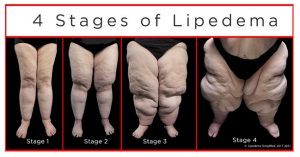
What is lipedema?
Lipedema is a relatively common fat disorder that is often mistaken for simple obesity. Its clinical diagnosis is an adipose tissue disorder or a lipid metabolism disorder. A typical lipedema patient is a woman who struggles with large hips and legs, usually out of proportion to the rest of her body. Lipedema also appears in the upper arms. One of the hallmarks of the disease is that lipedema fat is relatively unresponsive to standard diet and exercise. These measures may lead to weight loss in other areas, but the size of the hips and legs remains disproportionately large.
Lipedema is a disorder of adipose tissue distinguished by five characteristics:
1) it can be inherited;
2) it occurs almost exclusively in women;
3) it can occur in women of all sizes, from the seriously underweight to the morbidly obese;
4) it involves the excess deposit and expansion of fat cells in an unusual and particular pattern – bilateral, symmetrical and usually from the waist to a distinct line just above the ankles; and
5) unlike the “normal” fat of obesity, lipedemic fat cannot be lost through standard diet and exercise.
Early tell-tale signs of Lipedema are the development of a cuff around the ankle where the fat distribution stops (the foot is usually normal size)’ extreme sensitivity, pain, swelling, and easy bruising.
In later stages of Lipedema, the leg typically develops s column-like shape, and the skin begins to pucker.
As the disease progresses, the skin begins to develop hanging folds, and in the final stages the fat distribution can become serve enough to greatly impede mobility.
In the final stages, the fat and fascia can impede the flow of lymph by constricting the lymphatic vessels. When this happens, a secondary condition know as Lymphedema develops, When a person has both Lipedema and Lymphedema, the condition is then called Lipo-Lymphedema.
4 Stages of Lipedema
Stage 1: Skin surface smooth, subcutaneous fat thickened, fat structure fine knotted
Stage 2: Skin surface uneven, fat structure coarsely knotted
Stage 3: Tissue additionally coarser and harder, large lobed deforming fat lobes
Stage 4: Additional severe lipolymphedema
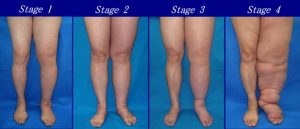
4 Stages of Lymphedema
Lymphedema is a progressive disease and develops in stages which can be categorized according to severity.
- Stage 0: the Latency Stage. A subclinical state where swelling is not evident despite impaired lymph transport. …
- Stage 1: Mild Stage. …
- Stage 2: Moderate Stage. …
- Stage 3: Lymphostatic Elephantiasis (Severe Stage)
Stages
- Stage 1: Abnormal flow in the lymphatic system. No signs or symptoms.
- Stage 2: Accumulation of fluid with swelling. …
- Stage 3: Permanent swelling that does not resolve with elevation. …
- Stage 4: Elephantiasis (large, deformed limb), skin thickening with “wart-like” growth and extensive scarring.
Lymphedema vs Lipedema
Lymphedema and lipedema (also known as lipoedema) are two distinct medical disorders even though both involve swelling in the arms and legs. In short, Lymphedema is a disorder of the lymphatic system and is commonly caused by dysfunction in the flow of lymph fluid through the arms or legs. Lipedema in contrast, does not involve the lymphatic system, but it is a pathologic, mostly symmetric deposition of fat that most often affects the lower extremities and almost exclusively occurs in women.
Lymphedema
- A disorder of the lymphatic system
- Blockage of lymphatic drainage causes tissue inflammation/damage
- Usually occurs after cancer treatment, but can be spontaneous (congenital)
- Usually affects one arm including fingers; one leg including feet and toes.
- Often associated with severe infections (cellulitis)
- Should be treated by a certified lymphedema therapist
- Worsened by obesity
- Can be caused by morbid obesity
Lipedema
- A disorder involving pathologic fatty deposits in legs and sometimes arms
- May be successfully treated by a Lipedema plastic surgeon
- Occurs spontaneously but may affect multiple family members
- Usually affects both legs and/or both arms equally
- Fatty deposits usually are painful
- May result in walking/gait abnormality and skeletal issues over time
- May benefit from treatment by a certified lymphedema therapist (CLT)
- Worsened by obesity
- May or may not be associated with obesity
- May be associated with lymphedema as well, especially in the legs
Himalayan Salt Stone Classic Massage

Himalayan salt stone massage is a unique and rejuvenating form of therapy that utilizes heated salt stones to provide a deeply relaxing experience.
During a Himalayan salt stone massage, heated salt stones are placed on specific areas of your body. Promoting detoxification and improving circulation. The warmth from the stones helps to open up your pores, allowing toxins to be released more easily from your body. At the same time, the gentle pressure applied during the massage stimulates blood flow, helping nutrients reach your cells more efficiently.
The combination of heat, minerals, and skilled touch can help balance your energy levels while promoting a sense of calmness.
BENEFITS OF HIMALAYAN SALT:
· Promotes healthy blood sugar
· Helps lower blood pressure
· Supports a healthy respiratory system and sinuses
· Boosts bone health and prevents muscle cramps
· Improves circulation
· Relieves anxiety and addresses insomnia
· Lightly exfoliates the skin and is highly relaxing
· Emits negative ions when heated, delivering a myriad of health benefits from higher mental alertness to protection against germs in the air
HOW TO PREPARE FOR HIMALAYAN SALT STONE SESSION
-
Drink at least two liters of water before your treatment and another two liters per day following your treatment (soft drink, soda, juice, or tea is not water).
-
Refrain from ANY alcohol consumption for 2 – 3 days following your treatments. Alcohol can prevent your liver from working to remove fats as it will make alcohol metabolism its priority before fat removal and could hinder your results.
-
Avoid eating 2 hours prior and 1 hour after your treatment.
-
Diet: We recommend a low carb, low starch, low sugar diet for the best results.
Hawaiian Lava Stone Massage

A Hawaiian lava stone massage, also known as Hot Stone Lomi Lomi, is an ancient healing practice that combines the use of warmed lava stones with long, rhythmic massage strokes. The stones, called pohaku, are used to soothe pressure points and ground the body, while the massage strokes, called Lomi Lomi, are symbolic of ocean waves.
BENEFITS OF HAWAIIAN LAVA STONE:
· Relieving muscle tension
· Arthritis
· Multiple sclerosis
· Fibromyalgia
· Relieving stress, fatigue, and insomnia
· Feelings of anxiety
· Improving blood circulation
· Aligning the mind, body, and spirit
HOW TO PREPARE FOR HIAWAIIAN LAVA STONE SESSION
-
Drink at least two liters of water before your treatment and another two liters per day following your treatment (soft drink, soda, juice, or tea is not water).
-
Refrain from ANY alcohol consumption for 2 – 3 days following your treatments. Alcohol can prevent your liver from working to remove fats as it will make alcohol metabolism its priority before fat removal and could hinder your results.
-
Avoid eating 2 hours prior and 1 hour after your treatment.
-
Diet: We recommend a low carb, low starch, low sugar diet for the best results.
Jade Stone Massage

Jade stones has been used as a massage and meditation tool for over 7,000 years by the Africans, Egyptians, and Mayans. A Jade stone massage is a therapeutic massage that uses heated and cooled jade stones on the body to relieve pain and tension and promote relaxation. The stones are made of iron, calcium, and magnesium, which are said to have healing properties. The effects of a Jade stone massage can last for up to three days. During a Jade stone massage, we use a variety of hot stones. They may be placed under and on your body, depending on your pain points. Smooth stones are used directly on your body and limbs to work out tension and promote deep relaxation.
BENEFITS OF JADE STONE:
· Balancing the body
· Relaxing the nervous system
· Decreases high blood pressure
· Improved sleep
· Increased circulation
· Releasing toxins and inflammation
· Slows down the aging process
HOW TO PREPARE FOR JADE STONE SESSION
-
Drink at least two liters of water before your treatment and another two liters per day following your treatment (soft drink, soda, juice, or tea is not water).
-
Refrain from ANY alcohol consumption for 2 – 3 days following your treatments. Alcohol can prevent your liver from working to remove fats as it will make alcohol metabolism its priority before fat removal and could hinder your results.
-
Avoid eating 2 hours prior and 1 hour after your treatment.
-
Diet: We recommend a low carb, low starch, low sugar diet for the best results.
Infrared Himalayan Salt Cave Sauna Therapy
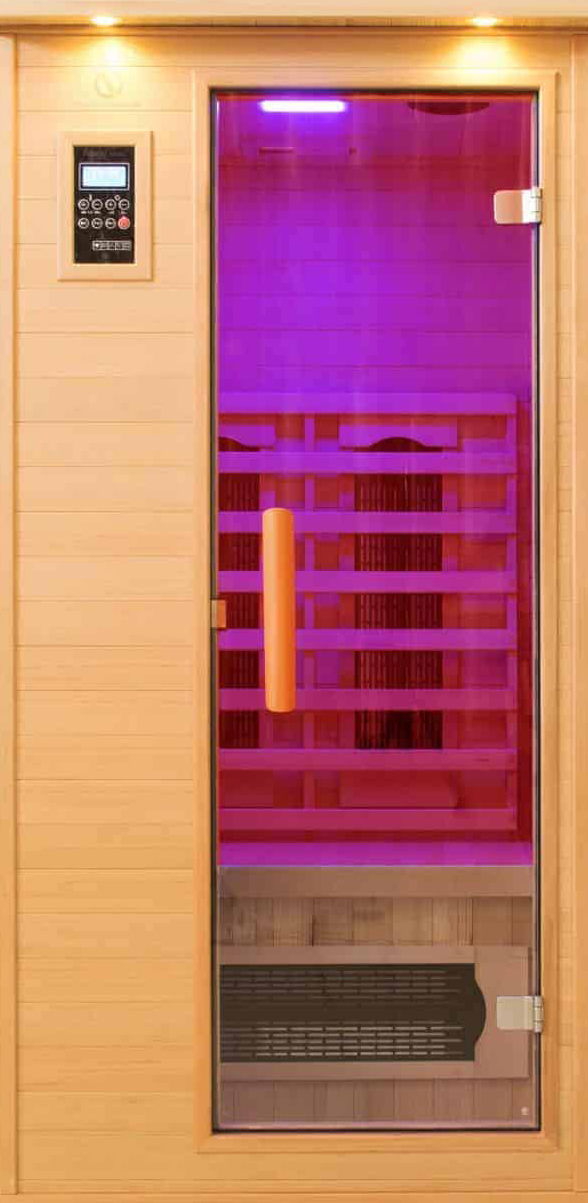
WHAT IS FULL SPECTRUM INFRARED SAUNA THERAPY?
Full spectrum infrared sauna therapy is a type of sauna that uses infrared lamps to emit radiant heat, which is absorbed directly by the skin. Unlike traditional saunas that heat the air around you, full spectrum infrared saunas penetrate the skin by up to 1.5 inches, allowing for a deeper, more effective therapy session.
A full spectrum infrared sauna emits all three wavelengths (near, mid, and far infrared). Which produces heat that penetrates pass the deep tissue, going beyond a detoxifying sweat, to encourage healing and revitalization on a cellular level.
FULL SPECTRUM INFRARED SAUNA BENEFITS
- Pain Relief
- Detoxification
- Stress Reduction
- Improved Circulation
- Cardiovascular Health
- Wound healing
- Physical Performance
- Immunity Boosting
- Relax Body and Mind
- Weight Loss
- Improved Sleep
- Longevity
- Anti-aging and Skin Rejuvenation
WHAT IS HIMALAYAN SALT THERAPY?
Himalayan salt therapy, also known as halotherapy, is a natural healing practice that involves breathing in salty air filled with tiny salt particles in a room. Salt Therapy or Halotherapy (“halos” Greek word for salt) uses aerosol salt micro-particles to aid in the therapy of respiratory diseases. These inhalable salt particles are under 5 microns in size, being easily able to reach the alveoli in the lungs. Salt therapy is a natural therapy that can help you to breathe better naturally. It is non-invasive, drug-free, has no side effects, and demonstrates significant results in aiding respiratory diseases, proved by clinical studies.
HIMALAYAN SALT BENEFITS
- Respiratory Health
- Skin Health
- Detoxification
- Heart Health
- Nervous System
- Air Purification
WHAT IS CHROMOTHERAPY?
Chromotherapy, also known as Color Therapy, is an alternative holistic health treatment used to improve health and alter your mood. Chromotherapy produces different colored lights within an infrared sauna to create positive change within your body as a mediative aid.
7 BENEFITS OF CHROMOTHERAPY
- Reduced Swelling
- Pain Relief
- Accelerated Healing
- Decreased Muscle Tension
- Improved Blood Circulation
- Improved Sleep
- Regulated Mood
7 CHROMOTHERAPY LIGHT COLORS
- Red: Brings warmth, energy, and stimulation; therefore, good for energy, fatigue, colds, chilly and passive people. It energizes the heart and blood circulation. It energizes all organs and the senses.
- Yellow: Increases neuromuscular tone. Purifies blood, helps digestion, and has a cleansing effect. Strongly stimulates happiness, brings on a sense of security, as well as a strong feeling of well-being.
- Green: Is a cooling, sedating color, which helps reduce swelling of joints and tissues; it calms the body’s nervous system. It’s the color of the relaxed heart.
- Turquoise: Increases intuition and sensitivity. It mentally relaxes and tackles embodied psychological barriers. It acts as a tonifier and can help regulate imbalances in the lung and large intestines system. It facilitates spiritual growth.
- Blue: Is a cool color that is calming. It stimulates the parasympathetic system and reduces blood pressure and calms both breathing and heart-rate. It helps treat sleep disorders and headaches.
- Violet: Promotes awareness and consciousness. It increases the effects of medication. It promotes proper functioning of the lymphatic system and is very helpful with menopause. It is the color for neutralizing emotional wounds and for spiritual growth.
- White: Symbolize purity and cleanliness. It’s also known for its ability to create a sense of space and mental clarity.

ABG WELLNESS
Oxygen Therapy & Lymphatic Therapy
after plastic surgery
Having plastic surgery or any other cosmetic procedure can be a very exciting time in your life, but we all know beauty can cause pain.
The good news is that plastic surgery recovery doesn’t have to be like this anymore! Many women and men are choosing to have hyperbaric oxygen therapy (HBOT) in conjunction with lymphatic balancing therapy after their cosmetic procedures.
How is Hyperbaric Oxygen Therapy beneficial for plastic surgery and cosmetic procedures?
Hyperbaric oxygen therapy works by exposing the body to an atmosphere of 100% oxygen while inside a pressurized chamber.
Hyperbaric Oxygen Therapy helps to reduce swelling and discomfort while providing your body with at least 10–15 times its normal supply of oxygen. Because of this, many doctors recommend HBOT to help plastic surgery patients recover faster after their cosmetic procedures.
We all need oxygen to heal properly. Exposing your body to 100% oxygen can accelerate the healing process by allowing more oxygen to reach treated areas. This gives your body the opportunity to heal and significantly improve—and in some cases totally relieve—your presenting symptoms after surgery.
How is Lymphatic Balancing Therapy beneficial for plastic surgery and cosmetic procedures?
5 reasons
- Reduced post-op swelling – Lymphatic massage reduces swelling
- Reduced post-op pain – Hundreds of patients and multiple studies show lymphatic massage to reduce post-op soreness
- Better overall results – By removing excess tissue and fluids under the skin, lymphatic massage helps you achieve better overall appearance
- Detoxification and Cleanse – As the go to lymphatic cleansing procedure, the drainage helps you flush toxins out of your body
- Relaxation and Energy – Patients often feel extremely joyful and energized for weeks after the procedure
Experience the benefits of a hyperbaric chamber with the special introductory rate of Three visits special for $99. Sign up today to enhance your recovery.
3 Sessions for
$99
Patients undergoing the following cosmetic procedures can benefit from having Hyperbaric Oxygen Therapy & Lymphatic Balancing Therapy pre- / post-procedure:
- Liposuction
- Facelift
- Mommy Makeover
- Brazilian Butt Lift
- Fat Transfers
- Breast Augmentation / Breast Lift
- Rhinoplasty / Nose Job
- Mentoplasty / Chin Augmentation
- Cyst Removal
- Tummy Tuck
- Blepharoplasty / Eyelid surgery
- Hair Transplants
- Kybella
- Gynecomastia Treatment
- Fillers / Botox
The top benefits of combining Hyperbaric Oxygen Therapy with Lymphatic Massage Therapy after plastic surgery:
- Speeds up healing and recovery with plastic surgery and reconstructive surgery by up to 75%
- Dramatically reduces post-surgical bruising, swelling and inflammation
- Scars have been shown to heal better with HBOT due to collagen production
- Decreased need for post-procedure pain pills
- Detoxification and Cleanse
- Relaxation and Energy
- Overall, less pain, fewer scars, less downtime for the patient—so you can return to work faster, looking and feeling beautiful!

